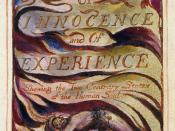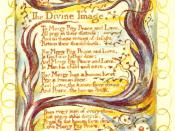"Love neighbor as you love yourself". This is one of the three great commandments of the Lord God. It is a quality of love, mercy, pity and peace. Human beings should acquire this sign of peace and respect for one another. These moral fibers are key traits of the divine image that is God. The Divine Image written by William Blake is more or less considered a 'teaching' of the good, perhaps a lesson for all human forms to acknowledge. Blake's poem for the innocence is expressed as simple pastoral language. Through certain literary techniques does Blake portray the qualities of the divine God and it is these characteristics we should be looking for if not obtaining.
William Blake though disagreeing sometimes with the Church is still religious and faithful to his Christian faith. Therefore it is not surprising to see many references to God and his religion in many of his poems.
The poem, The Divine Image, acts as a teaching, educating us human beings about the greatness of the Heavenly Father and as He is the Christian model, this approach to the innocence, the human soul and to children is certainly appealing to soul.
"For Mercy, Pity, Peace, and Love,/ Is God, our Father dear;/ And Mercy, Pity, Peace, and Love,/ Is Man, his child and care." (L. 5-8)
Because God is so divine, it suggests that we should obtain these qualities or look for them in other people. Line eight can signify God as 'Man, his child and care'(L.8), taken human form known as Jesus. The word 'Man', could also represent human beings in general. Since God created us in his own image, then it is likely that we should obtain his qualities of mercy, pity, peace, and love. Blake ends his poem with a concluding...


